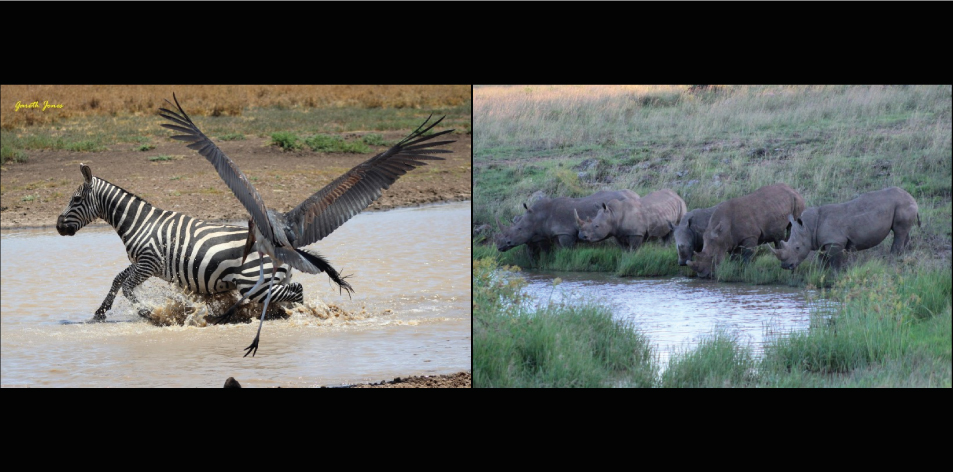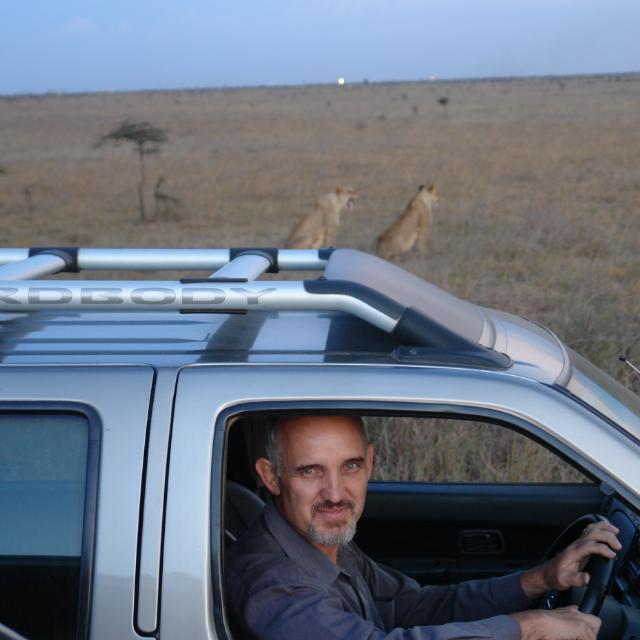
Water Is Life – Article by Gareth Jones
IN THE NAIROBI NATIONAL PARK WATER IS LIFE! – BY GARETH JONES
Over many years I have noted that most of us are still in “City mode” when we enter a national park, and would like to see as much of the created wonders as possible. Our challenge is to quickly snap out of “City mode” into “Bush mode”.
This week I thought it would be helpful to note some points that work for me. There is always something attractive about water, perhaps because it brings life. People also seem to be fascinated by water power like waves, waterfalls and flooding. The park has a number of water points spread across a wide area, and includes many dams like the Athi dam, and a number of seasonal streams that flow into the Mbagathi River.
During drier times when water levels are lower, it can be very rewarding to plan your visit to the park by maximizing your time at various water points. For example if you decide to spend time at the Athi dam, find a parking position that will ensure good clear vision, so that waiting will have wonderful rewards, as nature happens around you.
Very often large herds come and drink, like zebra, buffalo and Eland and sometimes Rhino. It is also interesting to watch the many bird species at the same time. Occasionally hippos and number of crocodiles can be seen. Sightings of predators like lions are also mostly seen by those who wait patiently. The following items are also useful, the Nairobi National Park – guide book, map, a good East African bird book, binoculars, a decent camera and some refreshments. I hope that your time waiting and watching at the water will be restful and be like a “soul tonic”.
This year the rains have been delayed beyond the normal expected timing, plus it has also been quite hot for a number of months this year. The combination of dry weather and heat has resulted in accelerated reduction in dam levels, to the point where many of the smaller dams are already completely dry. Even the well known Karen Primary dam near the No7 junction is also bone dry. Other nearby dams like the No6 dam and the Eland valley dam still have some water. The reason that these dams still have water is because the Kenya Wildlife Service used earth moving equipment last year to remove silted soil sediment and in doing so increased the depth of the dams. In contrast it should be noted that during the drought of 2007/8 the Karen Primary dam still had water in August 2008, such that over 1000 very thirsty wildebeest drank there. The main reason why the Karen primary dam and some other dams have dried up quicker than other dams is because of silted soil deposits, predominantly caused by the heavy rains of the last few years. Naturally a shallow dam holds less water, but shallow dams also have an accelerated evaporation factor due to the water temperature increasing. Hopefully the Kenya Wildlife Service will prioritise other shallow dams to increase the overall water retaining capacity within the park.
Apart from actual water availability, the condition of the water is also very important. The condition of water flowing into the park from Nairobi can also impact the park negatively. For example the well known Hyena dam has lost much of the reed and plant vegetation that grows used to grow around the dam, especially over the past two years. The vegetation was an important part of the water ecosystem, with many bird species also living and breeding in the reeds. Both uncommon and rarely seen bird species used to be seen at the dam, for example African rail, purple swamphen, Painted snipe etc. The Friends of the Nairobi National Park are currently arranging for water samples to be taken to a reputable laboratory for testing. The results of the testing should be a clear indication of the bio-health of this ecosystem. Various reasons are possible including chemical toxins and excessive sewerage waste from human habitation. It is hoped that the results of the laboratory tests will allow the Kenya Wildlife Service to take corrective actions to restore the biological balance within this sensitive ecosystem.
In contrast to this year, last year (2018 ) the long rains began promptly at the end of February, to start with there were not many flood situations, as the ground was dry and much of the water was absorbed. However as the weeks went by, the rains increased and continued, the previously dry ground reached saturation point causing the excess water to flow and flood.
Roads turned into rivers, and normally dry grasslands become wetlands, the park is started to look more like Lake Nairobi National Park. Perhaps KWS should introduce boat rides as tourist option? With this constant heavy rain, many of the roads become impassible for almost any vehicle. Many 4×4 vehicles were rescued with tractors, winches and various other muddy methods.
However even with heavy rains and just driving on the tar road and some of the drivable main roads, it is still amazing to note the variation of wildlife that can still be seen, with many of the species behaving differently due to the rains, some seemed to be celebrating by running around in the mud, or splashing in the water. Many bird species appeared to be hard at work with nest building and finding food. There are also many beautiful plants flowering now. In the Nairobi National Park there is always something interesting to see when it is wet and wonderful, and bursting with new life!
The park is currently looking very lush and green, but it is currently not advisable to visit if driving a normal passenger sedan, until the rains slow down and the roads are dry enough! Please be wise in the wet, while enjoying the wonderful spectacle of nature in this precious national park .
Let us hope and pray that sufficient rains will also fall over many parts of Kenya including the Nairobi National Park during April/ May/ June 2019, resulting in streams and rivers flowing as dams are filled and the dry land is transformed into a lush green wonderland of life.
The park is open daily from 06h00 to 19h00.
Gallery
 Gareth Jones – Nairobi Park Dairy – A passionate writer & photographer
Gareth Jones – Nairobi Park Dairy – A passionate writer & photographer
